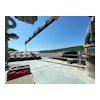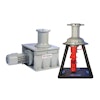What originally started as the Trans-Pacific Strategic Economic Partnership Agreement in 2005 among Singapore, Brunei, New Zealand and Chile — known as the Pacific Four (P4) Agreement — has evolved into what is now called the Trans-Pacific Partnership (TPP), potentially one of the most influential Free Trade Agreements in the last decade. While the TPP requires every country participating to eliminate all tariff lines by 2015, its main objective is to eliminate many non-tariff trade barriers, such as incompatible biotech and food and feed sanitation regulations.
The TPP is uniquely designed to allow additional countries across the Asia-Pacific region to join in negotiations. Since the original P4 was established, five countries formally committed to the TPP: the United States, Australia, Peru, Vietnam and Malaysia; while other new nations continue to express interest in joining.
As the scope of the agreement grows, so does the opportunity for the United States to create domestic jobs by increasing exports to a region that represents more than 40% of global trade.
Trade policy experts Gina Tumbarello, manager of international trade, American Feed Industry Association (AFIA), Floyd Gaibler, director of trade policy, U.S. Grains Council (USGC) and Gary C. Martin, president and CEO, North American Export Grain Association (NAEGA), weigh in on who could potentially be among our newest trade partners and provide a timeline of the agreement’s previous and ongoing developments.
Feed & Grain: What is the significance of the Trans-Pacific Partnership in regard to its influence on the future of trade policy development?
Gina Tumbarello, AFIA: The TPP is anticipated to be a “next-generation” agreement, setting the standard for future Free Trade Agreements. It will address new and emerging trade issues and is expected to include provisions on cross-cutting issues not included in previous trade agreements.
One such provision is making regulatory systems of TPP countries more compatible, allowing companies to work more smoothly in TPP markets.
Gary Martin, NAEGA: This is quite a large regional trade agreement, and it’s significant because it is being negotiated on the heels of the global economy’s frustration with the Doha Development Agreement. The TPP is poised to emerge as standard-setting, at least in the Asia Pacific region.
Floyd Gaibler, USGC: The significance of this agreement is that the original went beyond other traditional agreements by covering broader cross-cutting issues dealing with trade constraints along the global supply and production chain. The TPP requires regulatory coherence among the participating nine nations, which will result in more seamless and consistent trade between the countries.
Another unique quality of the original P4 agreement is that it was designed to easily allow future participants to come on board. The real importance of this is that it’s viewed as the beginning of an Asia regional economic agreement that would ultimately launch what’s been termed a “Free Trade of the Asia Pacific Region,” an approach trade policy experts have long advocated to the western hemisphere.
F&G: What is the likelihood that other nations will join the TPP?
Gaibler, USGC: Canada, Mexico and Japan formally expressed interest in joining the TPP at the November 2011 negotiation meeting. Each of these three countries has been undergoing consultations with all of the nine current members and it’s [the USGC’s] belief that all three will probably join at some juncture.
Tumbarello, AFIA: Negotiations between the TPP countries and Japan, Canada and Mexico have been ongoing. As it stands, it is believed that the United States, New Zealand and Australia are the only TPP countries not yet ready to commit to adding new trading partners to the negotiations. The other six TPP countries have completed their consultation process with the three [interested] countries and appear to be open to having them join the talks in the near term.
The United States is concerned that adding new countries at this juncture could slow down the momentum of the talks. There is speculation on when new countries will join. Some say it is unlikely to happen in the coming months; others say that is unlikely to happen until late this year, at the earliest. Mexico is aggressively working to join as soon as possible, which may be due to the upcoming presidential elections on July 1. Once the elections are held, a government changeover could delay Mexico’s inclusion in the TPP negotiations.
Other future potential TPP participants include the Philippines, Papua New Guinea, Costa Rica and South Korea.
Martin, NAEGA: Japan has expressed interest, but its concern over the management of food safety is legitimate. It’s largely an import-dependent country and so it struggles with how to open its food supply market without a complex set of controls. Once the major decisions regarding those systems have been made, the best thing the United States can do is to support Japan in their decision making, as it is one of the best customers of U.S. agriculture products.
F&G: What makes the Asia Pacific region such an attractive market?
Gaibler, USGC: For the United States it’s important because there are over 100 different trade agreements in the Asia Pacific region itself — some bi-lateral and some regional — and we have not been participating in those, yet we know Asia will be a key driver of global economic growth.
The individual TPP partners are relatively small nations in terms of their economic size and growth, but the current negotiators combined constitute the fourth largest trading partner for the United States. If Japan were included, then it would rank as the second largest trading partner for the United States and represent 36% global GDP.
I think at some point China will take an interest, as well as other countries like South Korea, Taiwan and the Philippines. Once they understand the significance of this and the economic power behind it in terms of enhancing trade flows, other countries will consider joining TPP. Adding China alone would almost double the scope of the agreement, but it may not be ready because they’re transitioning into being less reliant on exports and shifting their emphasis on increasing domestic production and utilization.
F&G: How will the TPP directly impact American grain handling and exporting companies?
Martin, NAEGA: Without the TPP, there are uncertainties in trading with these countries due to lack of regulatory compatibility with respect to the sampling and measuring of grain. Regulations vary so dramatically, especially in the developing world, resulting in risk premiums in the transaction. The TPP would reduce those premiums considerably by improving the authorization and management of all those considerations that cost money to manage, like crop biotechnology, quality characteristics and other issues related to safety, mycotoxins and pesticide residues.
The cross-cutting issues and improvements that would be contemplated in the TPP would give us a leg-up from the efficiency standpoint and drive a portion of the price back to the producer and further incentivize production, which is good for the entire industry because it will lower the risks that are currently managed by trans-boundary shippers.
Tumbarello, AFIA: Japan is the United State’s fourth largest feed export market and fourth largest agricultural export market overall. While most animal feed enters Japan duty free, Japanese barriers to U.S. livestock exports are more restrictive. [If Japan were to join,] eliminating existing barriers and leveling the international playing field for trade would further develop Japan as an export market for the United States. The United States would ultimately be exporting more feed to Japan in the form of value-added products such as meats and dairy products, and those sales would benefit the U.S. feed, livestock and poultry industries, and their customers.
F&G: What phase of negotiations is the TPP in and when might it go into effect?
Tumbarello, AFIA: There is speculation on the timing of the conclusion of TPP negotiations. Last November, the leaders of the TPP countries met and announced the outlines of the agreement and reiterated their commitment to completing a “comprehensive, next-generation agreement.” While at the same time, Japan, Canada and Mexico expressed interest in joining the TPP negotiations. There is fear of losing momentum in the talks due to interest by other parties to join. While the negotiations are still very much in process, the United States Trade Representatives (USTR) has expressed the desire to have some kind of outcome by the middle of the year.
The USTR has recently released their schedule of informal meetings in the TPP negotiations. These will be held prior to the next formal round of meetings in Dallas. This aggressive schedule addressing topics such as intellectual property rights, investment, technical barriers to trade and rules of origin, shows USTR’s commitment to moving forward with the negotiations despite interest by new parties, and their commitment to completing a high-level, comprehensive agreement.
USTR is expected to complete negotiations on as many chapters as possible by early June. However, several items are only recently being negotiated; and controversial items such as labor rights … may require more time. On the other hand, there is also concern that with the United State’s elections so near, there is unlikely to be any significant advances for fear that [no one] will want to make any big decisions and offer concessions without knowing who the next U.S. president will be. Timing is still very much up in the air.
Gaibler, USGC: Once the TPP partners come close to finalizing these negotiations, the Administration must grant it Fast Track authority, which means Congress will consider the agreement as a whole and it will be voted either up or down without subject to amendments or ratification.
This is important because countries will be reluctant to finalize sensitive negotiations or serious concessions knowing that someone in Congress can take those away by offering amendments. The Administration has already signaled it will submit the Fast Track legislation at the appropriate time.
Conclusion
The Asia-Pacific region holds a wealth of potential for U.S. economic growth, specifically within the agriculture sector, and industry stakeholders will continue to strongly support its passage by the U.S. Congress.
Once enacted, the Trans-Pacific Partnership will vastly improve trade between the United States and its TPP partners by more adequately addressing regulatory incompatibilities that exist today between some of the nine countries.
Although Japan, Canada and Mexico have announced intentions to join negotiations, the next round will take place in Dallas, TX, in May and is open only to those who have formally committed to the TPP’s provisions. The USTR will release a TPP negotiation update on its website by this summer.


















